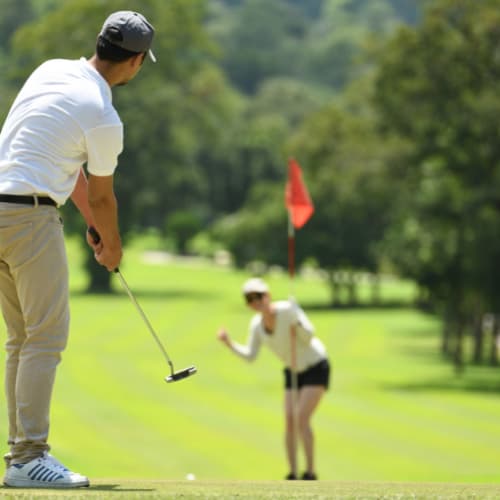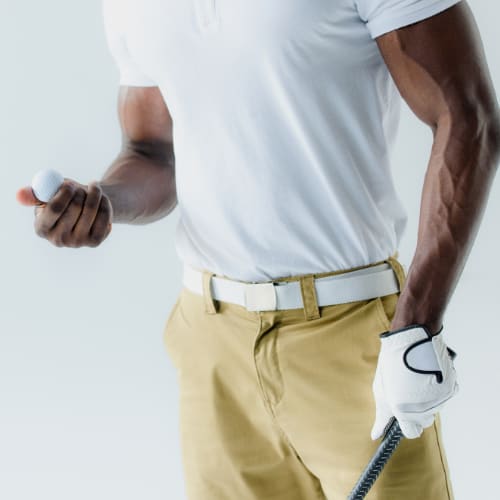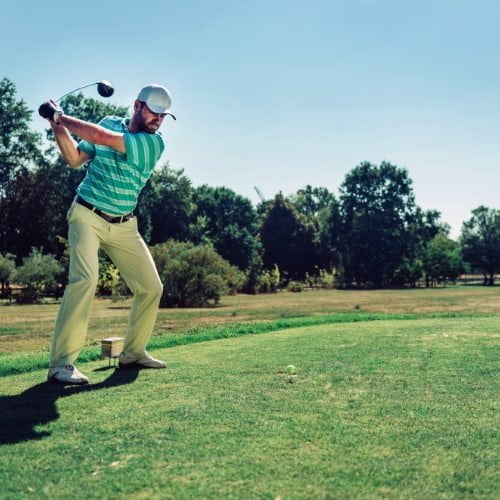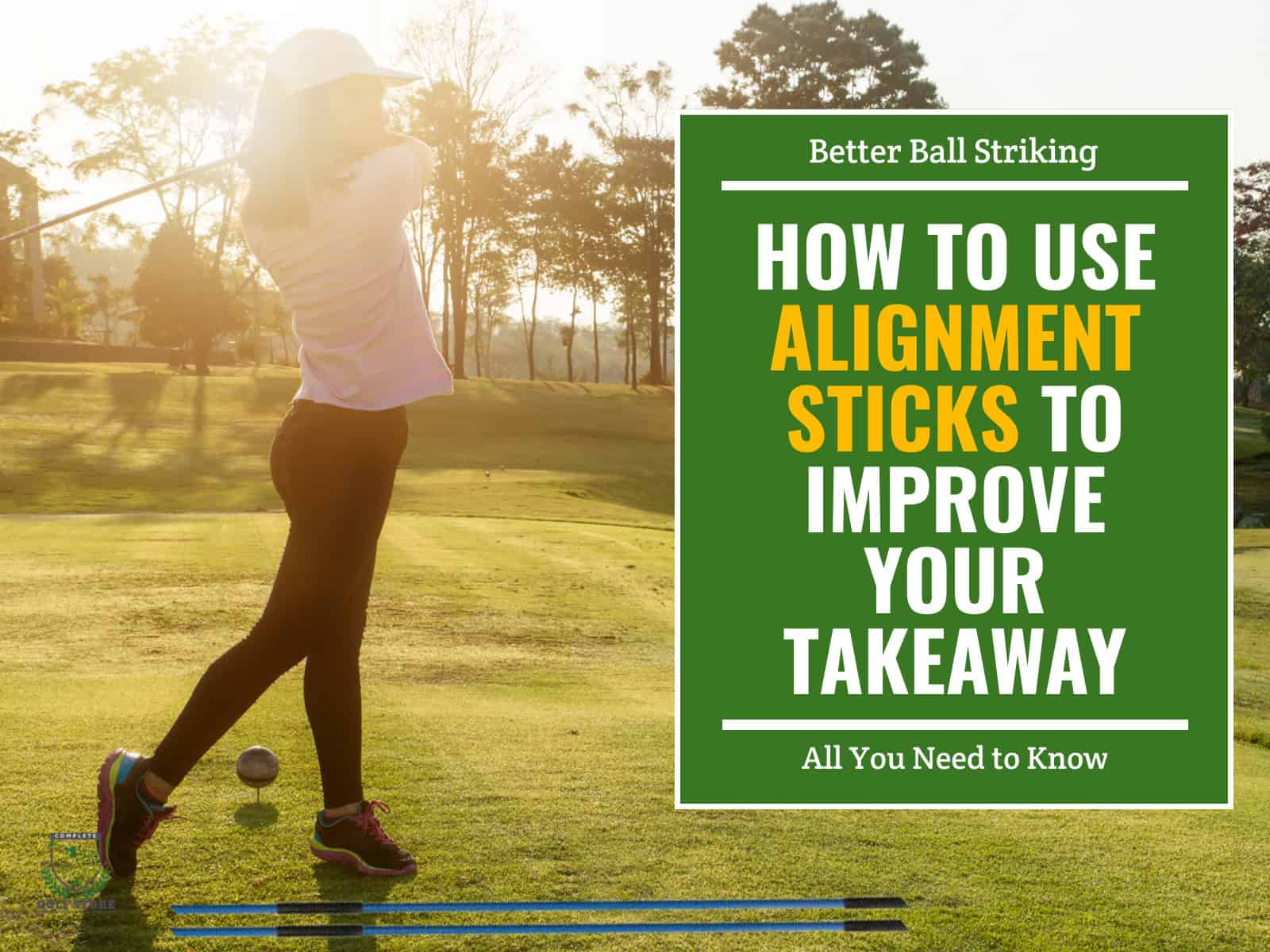Do you find yourself struggling to hit the ball straight, missing easy putts, hitting bad shots, and feeling disappointed on the golf course? If so, you may be experiencing the Frustrated Golfer Syndrome (FGS). This condition affects many golfers, regardless of skill level, and can be incredibly discouraging.
The sudden decline in golfing skill is often the result of various factors, including changes in grip, balance, swing mechanics, mental conditions, or injury. Additionally, lifestyle changes like stress, lack of sleep, and poor nutrition can affect your performance on the course.
The good news is that there are solutions. By understanding the root causes of your frustration and implementing some simple changes to your game and mindset, you can get back on track and enjoy playing golf again.
In this article, we’ll explore the common causes of the sudden decline in your game and provide practical tips and strategies to overcome it.
- 1) Start by Understanding Golf Performance
- 2) Common Challenges in Golf
- 3) Factors That May Be Affecting Your Golf Performance
-
4)
Detailed Technical Factors That May Be Affecting Your Performance Suddenly And Their Solutions
- 4.1) Ball Position Issues
- 4.2) Vision Problems
- 4.3) Grip Inconsistencies
- 4.4) Is Your Equipment Broken? Is It The Right Equipment?
- 4.5) Swinging Too Hard
- 4.6) Club Face Manipulation
- 4.7) Physical Injuries
- 4.8) Lack Of Balance
- 4.9) Do Your Practice Swing Motion
- 4.10) Changing Spine Angles
- 4.11) Anger
- 4.12) Consider Fixing Your Swing Tempo
- 4.13) Practice Smarter, Not Harder
- 4.14) Check Your Swing Path Regularly
- 5) Frequently Asked Questions
- 6) Conclusion
Start by Understanding Golf Performance

As a golfer, you know that your performance on the course can vary from time to time. Factors such as physical fitness, mental state, technical skills, and lifestyle choices all play a role in determining your Golf Performance.
If you’re suddenly experiencing a decline in your game, it could be due to a variety of factors. For example, if your physical fitness has declined, your swing mechanics may have suffered as a result. Alternatively, if you’re experiencing high levels of stress, your mental game could be affecting your decision-making on the course.
Understanding and managing these factors can help improve your Golf Performance. For instance, focusing on your physical fitness can improve your swing mechanics and help you hit consistent golf shots. Similarly, taking steps to manage stress and improve your mental game can help you make better decisions on the course.
Overall, improving your Golf Performance is a holistic endeavor that involves understanding all the factors that influence your game. With the right approach, you can take steps to manage and improve each of these factors, ultimately helping you reach your full potential as a golfer.
Common Challenges in Golf

You may be experiencing some common challenges that can affect your performance on the course. These challenges include inconsistent swings, lack of accuracy, difficulty with putting, mental distractions, and adapting to different course conditions. To address these issues, it’s important to identify the specific problem.
Inconsistent swings can be caused by improper swing mechanics or simply a lack of practice time. To improve your swings, work on your swing mechanics through practice swings and expert feedback. Additionally, make sure to allocate ample practice time to perfect your skills.
Lack of accuracy in your golf shots can be resolved through a neutral grip, and finding the best impact position. Additionally, it’s important to create a pre-shot routine to help you focus before each shot. This routine helps your conscious mind to remain focused on the shot, and not be distracted by external thoughts.
Difficulty with putting can be resolved by ensuring that your putt style and swing mechanics match the conditions you are facing. Avoid letting your mind wander and stay focused on the task at hand.
Finally, adapting to different course conditions requires skill and mental focus. It’s important to carry different clubs in your golf bag to cover all distances, and practice different shots such as straight shots, bunker shots and tee shots.
Factors That May Be Affecting Your Golf Performance
Golf is a game that requires a combination of physical and mental skills to excel at. Amateur and professional golfers alike sometimes struggle on the course and find themselves suddenly terrible at golf. Let’s explore some of the factors that can lead to a decline in golf performance and offer solutions to help improve overall play.
Physical Factors
Lack of flexibility, strength, and stamina can hinder your ability to execute powerful and controlled swings, leading to bad shots and inconsistent performance. Poor posture and alignment can also affect your ball-striking consistency.

To improve your game, it’s crucial to incorporate golf-specific exercises into your workout routine to improve your physical capabilities on the course. This can improve your flexibility, strength, and stamina, leading to a consistent and reliable golf swing.
Additionally, it’s essential to ensure proper alignment and posture when addressing the ball to maximize your ball-striking consistency.
Physical factors can have a significant impact on your golf game. But with proper exercise and attention to posture and alignment, you can improve your ball-striking consistency and regain your confidence on the course.
Mental Factors
Negative thoughts, stress, and anxiety can disrupt your concentration and negatively affect your decision-making and execution.

To overcome these hurdles, adopt techniques such as visualization, positive self-talk, and mindfulness, and build your mental resilience. Focus on cultivating a positive outlook about your abilities on the golf course. Confidence is key, and it can lead to consistency in your golf game.
Here are some tips:
- Practice visualization techniques before hitting your golf shot. Imagine the desired result.
- Use positive self-talk to reinforce your confidence.
- Incorporate mindfulness practices like deep breathing and visualization to relax and stay focused.
- Challenge negative thoughts and replace them with positive ones.
- Focus on the shot in front of you, and don’t dwell on past mistakes or future shots.
Remember to invest in your mental game, and your golfing skill will improve over time.
Lifestyle Factors
Here’s how various lifestyle factors can impact your golf performance:
- Sleep patterns: insufficient sleep can lead to poor focus and lack of energy on the course.
- Nutrition: imbalanced diets can cause fatigue, poor concentration, and mood swings that can affect your golf performance.
- Hydration: dehydration can lead to fatigue, headaches, and difficulty concentrating, which can have a negative impact on your golf performance.
- Well-being: stress and anxiety can impact your mental and emotional state and lead to poor performance.
To help improve your performance on the golf course, you should aim to adopt a healthy lifestyle that promotes adequate sleep, balanced nutrition, and hydration. Here are some tips on how to achieve a healthier lifestyle:
- Aim for at least 7-8 hours of sleep per night.
- Eat a balanced diet that includes plenty of fruits and vegetables, lean proteins, and whole grains.
- Stay hydrated by drinking plenty of water before, during, and after your game.
- Take care of your mental and emotional well-being by relaxing, meditating, or practicing yoga.
By taking a holistic approach to your health and wellness, you’ll not only see improvements in your golf game but also in your overall well-being.
Technical Factors
These include grip, alignment, stance and swing mechanics. Your grip may be too strong or not neutral enough. Your alignment may be off, or your stance may not be balanced. Your swing mechanics may need improvement, such as your impact position and club head at impact.
To improve your technique, seek professional coaching or use video feedback to assess your swing. Analyzing your movements can help identify areas for improvement.
In addition, Practice regularly to develop muscle memory and integrate specific golf-related workouts into your exercise routine to enhance your physical capabilities on the course. Remember, technical factors play a crucial role in determining your accuracy and consistency, so it’s essential to improve them to achieve a better game.
Detailed Technical Factors That May Be Affecting Your Performance Suddenly And Their Solutions
Let’s explore in more detail some technical factors that may be affecting your performance suddenly and what you can do to overcome them.
Ball Position Issues

Incorrect ball position can result in topping or duffing the ball. Position the ball forward for drivers and fairway woods, in the middle for mid and long irons, and back or center for short irons.
Losing balance can also ruin a perfect golf shot. To prevent this, hold your finish until the ball stops moving and ensure that you’re not off balance during your swing.
Incorrect posture, grip pressure, and spine angle can also lead to position issues. Check your ball position, balance, correct posture, grip pressure, and spine angle, and improve your golf skills over time. These are all related and affect the ball’s position vis a vis the player, and club.
Vision Problems
Vision issues can be one of the reasons for suddenly becoming terrible at golf. Failing to see the ball clearly can lead to a disconnect in hand-eye coordination, causing you to miss the ball.

Some golfers use special glasses or sunglasses with colored lenses that enhance contrast and improve clarity.
If you’ve just purchased new glasses or sunglasses, make sure they fit properly for golfing. Another solution is to find a golf club with less glare. Using a colored golf ball can also help you see the ball better.
Grip Inconsistencies
Your golf game can suffer when your grip is inconsistent. The grip’s position determines your shot shape and accuracy, making a consistent grip crucial.

A neutral grip is a great starting point to achieve a consistent golf swing. Other types of grips include the Vardon, interlock, and ten-finger, each with different effects on the clubface angle at impact.
To achieve a neutral position, make sure the V’s between your thumb and index finger on both hands point straight up. Mastering a consistent and neutral grip may be challenging, but it’s an essential component of becoming a better golfer.
If you are interested, you can check out our detailed guide on golf grip; you can find tips and advice on how to have the best grip for optimal performance.
Is Your Equipment Broken? Is It The Right Equipment?

When something goes wrong with your equipment, it can make things even more difficult. In particular, broken equipment can be a significant issue for golfers, especially when it comes to graphite shafts.
While this is not something very common, dealing with broken equipment can be incredibly frustrating, particularly if it’s something that you haven’t caused yourself.
While it’s important to take care of your equipment, sometimes things just wear out or break due to wear and tear. This is especially true if you’re an avid golfer who spends a lot of time on the course.
When faced with a broken club, it’s important to stay positive and focused on the things that you can control. Instead of getting frustrated and angry at the situation, try to focus on your mental game and the positive self-talk that can help you stay calm and confident during difficult moments.
Regular cleaning and inspection of equipment are always recommended. Don’t let a broken club ruin your game!
Also, when buying new golf gear, it’s crucial to ensure it fits your height and swing style and speed. When buying a new golf club set, for instance, you need to check the shaft length and flex rating as well as the gender (male or female) and age (senior, kids, etc.) match to get the most out of your new investment. Using inappropriate equipment will potentially ruin your game.
Swinging Too Hard
Many amateur golfers believe that the harder they swing, the farther they’ll hit the ball.

However, this mindset can lead to bad swings resulting in poor shots. Instead, try to swing within your means and apply club head speed correctly for distance and accuracy.
Not taking enough practice swings can also affect your golf shot negatively.
Swinging too hard can cause various problems such as a too closed or open clubface, inconsistent ball flight, and difficulty hitting greens in regulation. These issues can lead to all types of bad shots, including slices, hooks, and thin & fat shots.
Club Face Manipulation
A square clubface is necessary for consistent ball striking. So, if you’re struggling with terrible shots, take a step back and assess your clubface manipulation.
Most golfers adjust their clubface to avoid hooking or slicing the ball, but extreme manipulation can lead to terrible shots.
Closed clubfaces can lead to low hooks or blocked shots, while open clubfaces can cause slices or weak shots. You may have a closed clubface to avoid slicing due to a fear of hitting the ball with an open face.
To fix clubface manipulation, ensure a proper grip with neutral wrist extension and focus on aligning the clubface square to your target.
You can try an exercise using a door jamb – hold the club against it to ensure proper setup and alignment. Use a visual aid, like holding the club against a wall, to understand clubface alignment.
Physical Injuries
Prioritize your recovery by consulting with a medical professional to determine the severity of the injury. Once you have a diagnosis, you can either figure out how to accommodate the injury or take time off from playing until recovery.

In the meantime, you can work on other aspects of your golf game that do not require the use of the injured body part.
For example, you can focus on your mental game, such as perfecting your pre-shot routine or visualizing your shots. You can also practice your swing style or work on your putting skills.
It’s important to remember that injuries are a common occurrence for both professional and amateur golfers, and taking the time to recover properly will benefit your game in the long run.
Lack Of Balance
One of the most common issues many golfers face is finding themselves suddenly unable to maintain their balance during a swing. This can result in a shanked ball or completely miss-hitting the ball, causing it to go off course.
The good news is that this problem is easily fixable with some conscious practice and perseverance. To maintain balance through your swing, it is necessary to transfer weight from your left leg towards the right foot, then back to the left side on follow-through (if you are a righty). This helps create a strong foundation for the follow-through, ensuring that your body’s weight is properly supported.
Another useful practice is to hold the finish position even after hitting the ball. This helps train your body to maintain balance and a steady footing, ensuring that you don’t fall off balance when (or before) the swing is complete. Additionally, taking practice swings before starting a round can help establish a feel for the club’s length and prevent any inconsistencies with contact.
It’s important to remember that losing balance during a swing can ruin an otherwise good shot. Therefore, it is essential to work on coordination and muscle strength regularly to improve balance.
Do Your Practice Swing Motion

If you are used to taking a few practice swings before your shots, chances are that practice swing motions are an integral part of your pre-shot routine. Skipping your practice swing(s) may lead to degraded performance.
Fixing this issue is straightforward: Don’t skip your practice swing and pre-shot routine and make sure you go through them because they prepare you mentally (and physically) for the shot you want to make.
Changing Spine Angles
You need to keep your spine angle constant from address to impact with the ball. Any deviation in spine angle can lead to an incorrect swing path, and this can result in mishits, hooks, slices, and bad shots.
Here are some steps to improve your posture and maintain that ideal spine angle.
- First, flex your knees slightly to get a solid base.
- Second, twist your body until you feel comfortable and free.
- Third, anchor your lower back while pushing your buttocks back.
These steps will help you achieve the proper posture required to maintain a consistent spine angle.
To further illustrate this point, you can watch a video (14 min. 45 sec.) where golf coach Eric Cogorno, describes and demonstrates how to achieve this ideal posture and spine angle.
Anger
Anger can have a negative impact on your golf performance and cause tension in your body, affecting your swings and overall game.
When anger arises, take deep breaths, relax your body, and think positively to release the tension.
Recognizing the triggers of anger and developing coping techniques like meditation or mindfulness practices can be helpful.
Also, taking breaks from the game when frustration arises can prevent anger from building up. Keep the right mindset and don’t let anger ruin the game.
Consider Fixing Your Swing Tempo
Slowing down your swing doesn’t necessarily mean you’ll lose distance. Rather, it helps you consistently strike the ball with precision and accuracy.
Capture your swing on video from multiple angles using a quality golf simulator and use the data to analyze your tempo.
To perfect your swing mechanics, and specifically tempo, we have a dedicated guide with drills to fix and optimize your golf swing tempo.
Practice Smarter, Not Harder

Practicing smarter rather than harder can help improve your game. Creating a practice plan can build both skill and confidence. These are a few tips to help you out:
- Start small, with half-wedge shots, and work your way up to short-to-mid irons and long irons and woods.
- You can also use alignment sticks to check the aim when changing targets.
- To improve consistency, imagine hitting a shot on the golf course at the same yardage and play the shot on the range the same way.
- Incorporate technique-building practice that mirrors on-course play to achieve consistency.
- Seek feedback from your instructor and incorporate half swings to improve timing and arm-body connection.
Check Your Swing Path Regularly
The swing path refers to the direction the clubhead travels during your swing, and it greatly influences the flight of the golf ball. Your swing path can affect everything, from accuracy and consistency to shot shaping.
In addition, paying special attention can be a great way to identify problems with your swing mechanics. For instance, If you consistently hit slices or hooks, analyzing your swing path can reveal the root cause and allow you to make necessary adjustments to correct it.
This is because your swing path determines the kind (and area) of contact between the golf club and ball at impact, which affects the ball’s flight path. A good swing path will ensure optimal contact (closest to the club face’s sweet spot) and better contact, ball flight and distance.
To check your swing path, you can consider the following methods:
- Video Analysis: Record your swing from different angles and review the footage to observe the path of your clubhead. This visual feedback can help you identify any deviations from the desired swing path.
- Impact Tape or Foot Spray: Apply impact tape on the clubface or use foot spray on the club head. By examining the mark left on the tape or spray, you can assess the clubface angle at impact and the path of your swing.
- Swing Training Aids: Various training aids, such as alignment rods or swing plane trainers, can provide feedback on your swing path. These aids can help guide your club along the desired path and give you a better sense of the correct movement.
Frequently Asked Questions
Let’s now focus on some of the most frequently asked questions related to the topic at hand. We will provide answers to help you figure out what’s causing a sudden decline in your performance on the course.
Why Am I Getting No Better at Golf?
While it’s natural to experience a few bad rounds, consistent stagnation may indicate an issue with your impact or consistency during your swing.
Rather than trying to tackle all aspects of your game at once, try practicing drills that target specific muscles and honing in on mental concentration and relaxation techniques before hitting the ball.
Seek out expert feedback and set specific goals to work towards.
Remember, discomfort is a crucial aspect of improvement, so don’t be afraid to challenge yourself.
Does Playing Golf Everyday Make You Better?
Playing golf on a daily basis can significantly improve your game. Also, balancing practice and rest is critical to ensure that you do not burn out physically.
Aim to practice for 1-2 hours each day, three times a week (if you can) to enhance your hitting abilities, while also taking enough rest time. You can practice on the course, the driving range or using a golf simulator. If you don’t have access to any of those, you may simply practice in your backyard lawn using your clubs, balls and a golf net like this one. You may also use modern technology to your advantage by investing in a good golf launch monitor.
Frequent practice sessions will Improve your gameplay by identifying weak spots after each round. It will also improve consistency in your long, mid, and short game, which is key to playing better overall.
Can Hit Woods but Not Irons?
If you find yourself struggling to hit irons but can hit woods with ease, it’s likely an issue with your posture and position when addressing the ball.
Focus on keeping your weight forward and your hands in front of the ball at impact. Additionally, consider getting fitted for a driver that matches your game and swing style.
If hitting from a high tee, try using a shorter iron or changing your equipment if using an incorrect club. Remember to replace your irons after if they show any signs of wear and damage. A good rule of thumb is that irons should be replaced after around 300 rounds (maybe more) to ensure optimal iron play.
Is it possible to lose your golf swing?
Yes! Losing your golf swing can be frustrating, but it’s common among golfers.
Possible reasons include physical factors like injury or changing spine angles, mental factors like overthinking or anger, lifestyle factors like lack of sleep or poor nutrition, or technical factors like a broken grip or clubface manipulation.
To address these issues, focus on improving your swing tempo through slow and controlled practice, practicing smarter by focusing on specific areas of improvement, and checking your swing path regularly.
Remember to address both physical and mental factors to regain your swing.
How long does it take to get consistent at golf?
Getting consistent results in golf takes persistence, practice time, and patience.
Although it may seem impossible to achieve immediate success, learning and improvement come with time. It takes an average of 6-12 months of consistent practice and play for amateur golfers to develop a more consistent swing.
You can ideally play golf once to three times a week and practice for 1 to 2 hours to improve. The more and longer, the better!
Professional golfers spend more than 6 hours a day practicing, and player fitness is now the third most important factor contributing to the increasing distances being hit at the professional level. They also spend time in the gym and on the golf course to achieve their goals.
It’s important to be clear on what your target is to determine how much you should be practicing and playing. With dedication, persistence, and patience, you can become a consistent golfer over time.
Remember, golf is a lifelong game, and improvement is an ongoing process. Keep practicing, be patient, and enjoy the journey.
Conclusion
If you’re suddenly terrible at golf, there are a few key areas to focus on that can help improve your performance. Make sure to work on grip setup, ball position, posture, alignment, and rhythm. These may seem like small adjustments, but they can make a significant difference in the way you play.
Getting professional assistance from a coach or instructor, investing in a quality launch monitor or golf simulator, etc. are all great ways to improve your game and fix any issues causing the decline in your performance.
Consistency and dedication are essential if you want to see improvement, so organize your time, set your weekly practice sessions and try to set clear objectives. By following our tips and advice, we guarantee that you will be able to reverse the situation faster.
If you have further questions or comments, please feel free to reach out through a comment or via email.
Good luck!




